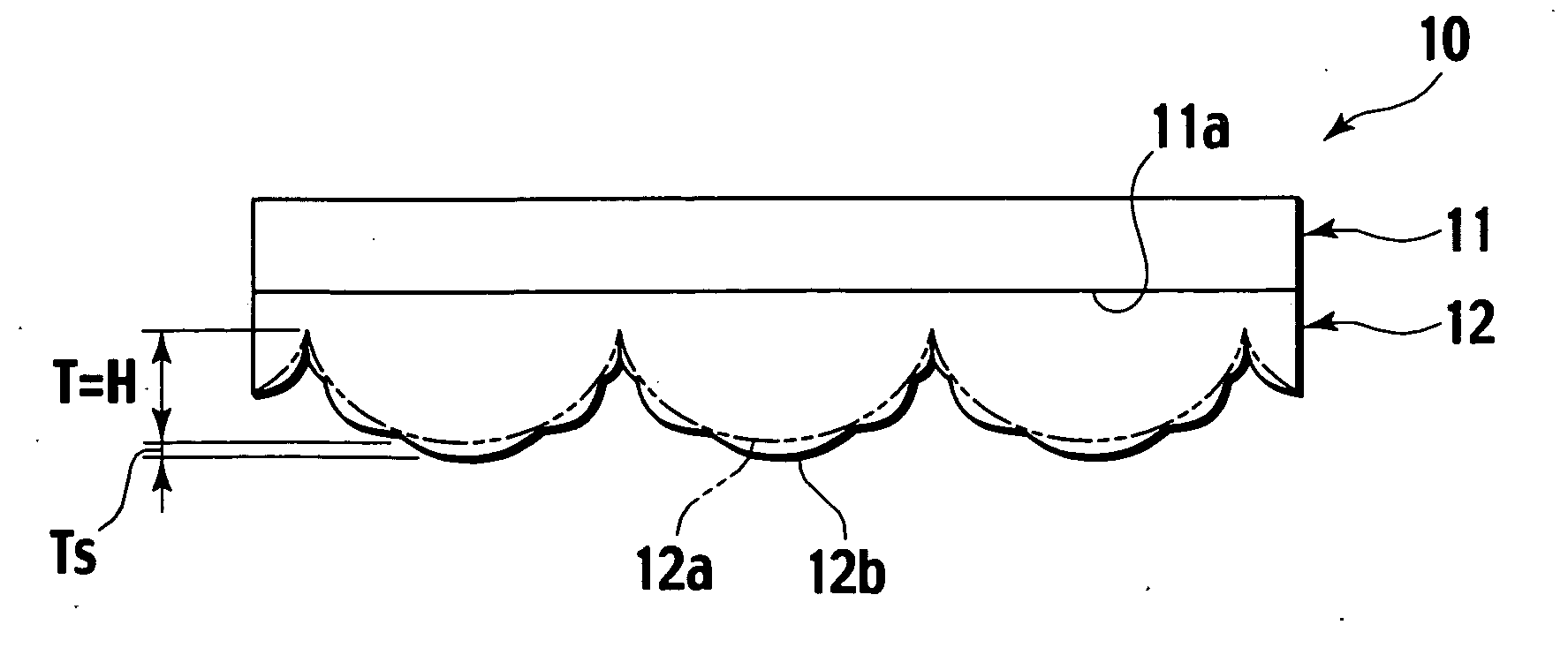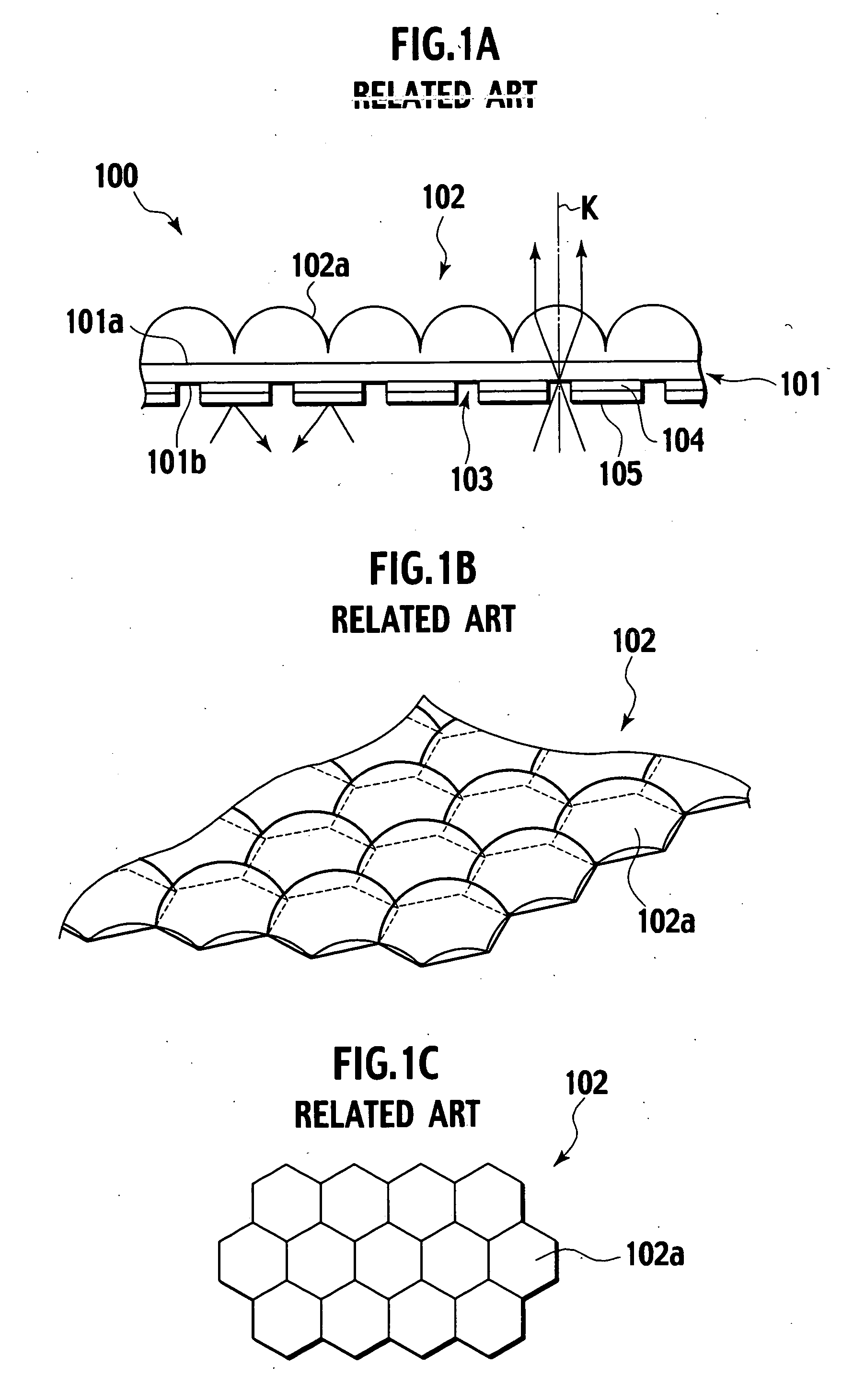Micro lens array and a method of manufacturing a replication mold for the same
- Summary
- Abstract
- Description
- Claims
- Application Information
AI Technical Summary
Benefits of technology
Problems solved by technology
Method used
Image
Examples
first embodiment
A First Embodiment
[0052]FIGS. 3A, 3B, and 3C are a front view, a perspective view and a bottom view of a micro lens array according to a first embodiment of the present invention, respectively. FIG. 4 is an explanatory drawing for generally explaining a focal length f of the convex lens having a curvature radius R. FIG. 5 is an enlarged view of one of micro lenses constituting the micro lens array shown in FIGS. 3A to 3C.
[0053] As shown in FIGS. 3A to 3C, a micro lens array 12 according to the first embodiment of the present invention is composed of a lens substrate 11 having an optical transparency and a micro lens array formed integrally on an upper surface 11a of the lens substrate 11. The micro lens array 12 is formed of an optically transparent material and the lens substrate 11 has substantially the same optical transparency as this material.
[0054] More specifically, the lens substrate 11 serving as a base material for a micro lens array element 10 is formed of a resin subst...
example 1
[0121] Firstly, a soda glass substrate 21 having a thickness of 3 mm was prepared as a starting material for a replication mold for a micro lens array. Then, a dry film 22 of 50 micrometer thick was pressed onto the upper surface 21a of the soda glass substrate 21 and heated to be attached thereon.
[0122] Next, a negative mask 23 having alternatively a black portion 23a for blocking light and a transparent portion 23b for allowing light to pass therethrough was placed on the dry film 22. In the negative mask 23, a pitch Px between adjacent two black portions 23a was set, for example, to be 90 micrometers. By the way, a plural of negative masks 23 having the same pitch Px of 90 micrometers and a respectively different width Ax along the X-axis of each black portion 23a were prepared in advance.
[0123] Then, UV-light 24 was exposed to the negative mask 23 from above, thereby forming an unexposed (unhardened) portion 22a at a position in the dry film 22, the position corresponding to e...
example 2
[0132] In Example 2, the micro lens array was manufactured in the same way as Example 1 except that the pitch Px of the openings 22a1 in the dry film 22 was set to be 30 micrometers. The results are listed in FIG. 10B. In FIG. 10B, D is the micro lens bottom face width or the micro lens bottom face diameter as described above, and Dsav is the average sub-lens bottom face width obtained by averaging a plural of the sub-lens bottom face widths Ds or the average sub-lens bottom face diameter obtained by averaging a plural of the sub-lens bottom face diameters Ds.
[0133] From FIG. 10B, it is found that substantially the same result as Example 1 is obtained. In other words, when the width of opening 22a1 in the dry film 22 is changed, the micro lens bottom face width (micro lens bottom face diameter) D remains substantially constant at 130 micrometers for example. This result suggests that any adjacent two micro lens 12a be in a close contact with each other. In addition, the height T (F...
PUM
| Property | Measurement | Unit |
|---|---|---|
| Electrical resistance | aaaaa | aaaaa |
| Width | aaaaa | aaaaa |
| Area | aaaaa | aaaaa |
Abstract
Description
Claims
Application Information
 Login to View More
Login to View More - R&D
- Intellectual Property
- Life Sciences
- Materials
- Tech Scout
- Unparalleled Data Quality
- Higher Quality Content
- 60% Fewer Hallucinations
Browse by: Latest US Patents, China's latest patents, Technical Efficacy Thesaurus, Application Domain, Technology Topic, Popular Technical Reports.
© 2025 PatSnap. All rights reserved.Legal|Privacy policy|Modern Slavery Act Transparency Statement|Sitemap|About US| Contact US: help@patsnap.com



